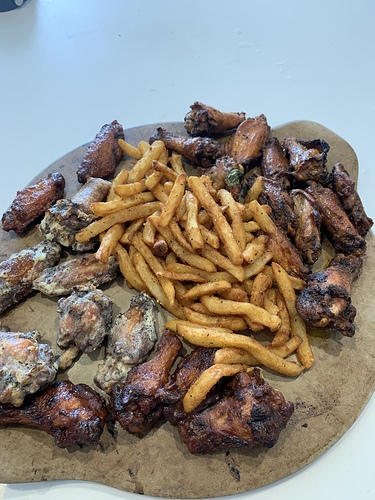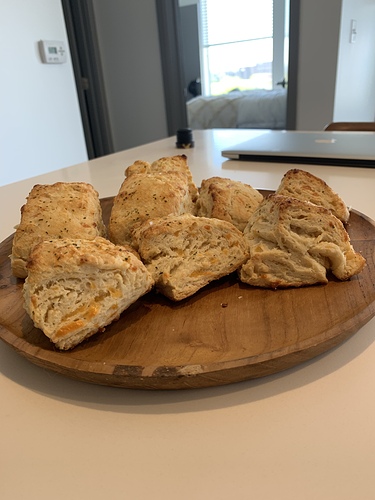So it might offend the bread bros here and i haven’t tried myself, but the Israelis in America crowd on facebook are all about Rhodes dinner rolls. They buy the frozen ones, roll it to a shape of a pita, leaven and bake.
I get about 600.
I wouldn’t worry about heat. A searzall gets like 1900 degrees. People use them for steak all the time.
Good to know. I was just a little worried that mine wasn’t powerful enough for good results.
Diminishing returns for surface temp on one steak probably starts at 500F. Higher than that, you’re going to end up burning the sugars in the steak and not actually caramelizing them in a beneficial way unless you’re exercising some good temp control manually during cooking.
The higher preheat temp would benefit a larger food volume. Like maybe a big ass pork loin or a big roast.
I’d also max out the temp for a crust, like au poivre.
Is…is that a giant cookie covered in wings?
Pizza stone that I heat up to KILL ALL THE COVID.
i like mosdef’s idea better 
I consider myself a decent home chef and Wookie’s food always puts me to shame. A good book that no one mentioned Yet is Ruhlman’s “Twenty”, basically twenty essays in cooking concepts/techniques with accompanying recipes. It’s a pretty good sized book but the essays are not at all intimidating and it definitely took my cooking to another level. In fact I’m probably due for another read, especially of the oven techniques. I did just buy The Food Lab as well since Kenji has been killing it even more than usual during the time of COVID (feeding hungry people and now doing a free YouTube cooking show). I haven’t started on it yet and it’s intimidatingly massive.
Making a pot roast tonight and I saw a recipe that said to whisk cornstarch into red wine vinegar to make the gravy, anyone ever try that? I was going to do the cornstarch but never would’ve considered red wine vinegar. I used red wine to deglaze the pan after cooking vegetables, seared the roast and mushrooms, and seasoned with Worcestershire, smoked paprika, thyme, celery seed, and soy sauce (an America’s test kitchen trick). I’d share a pic but it ain’t that pretty.
Oh I did carrots, onions, and potatoes, nothing fancy for veg.
Seems like red wine vinegar would be fine. The acid will be a boon if you don’t go overboard.
Yeah I just tasted it after it finished cooking and it was real nice.
Late to the book discussion.
I don’t really follow recipes as written. I modify things. Sometimes, I come up with the basic concept of what I want to do, then research how to accomplish my basic goal.
One book that I like is Mark Bittman’s How to Cook Everything. I’ve never actually used a recipe out of it, but I found it useful for getting an idea of the scope of what you can do with every ingredient. I page through it now and again for ideas.
Another book that I sometimes use is The Flavor Bible by Karen Page and Andrew Dornenberg, which lets me figure out what ingredients go well together.
So, let’s say I buy some kale. What do I do with kale?
The Flavor Bible tells me that techniques for cooking kale include blanching, boiling, braising, sauteing, steaming, and stir-frying. It goes really well with thyme, chicken stock, salt, red pepper flakes, onions, olive oil, and especially garlic. It also works with other ingredients such as tomatoes, sweet potatoes, roasted meat, sausage, among other ingredients.
Then, I can go to How to Cook Everything and turn to the vegetable section. It starts by talking about general use of techniques such as steaming, sauteing, and braising. Then, I can go to the part specifically about kale, which will tell me what to look for in buying it and how to store it (loosely wrapped in plastic in the refrigerator), how to prepare them, how to cook them, how to tell they are done, and what you can use to substitute. Plus, there are some kale-specific recipes with options.
So, I’d be looking at adding it to chicken soup; making a blended soup with onions, potatoes for texture, pancetta, maybe some cream/butter and a touch of heat; or as a sauteed side with roast pork. Depending on how I feel, I will wing it or look for more structured ideas to modify or borrow bits from.
Once you read a lot of recipes, you start to notice patterns and can figure out how to make recipes your own by substitution or addition of ingredients.
Apple cider vinegar might be better than red wine vinegar if you are making pork or chicken. I’ll have to try that next time instead of using wine or sherry.
I think that YouTube is a much better format for learning to cook than a cookbook. There are lots of good YouTube channels with videos under 10 minutes that show you how to cook things. Seeing the process is more helpful than reading a recipe.
Everyone has different learning styles. I do better absorbing info through reading. Same thing with poker, I remember concepts better from reading than watching video.
Video can help me learn specific techniques better, but I understand the theoretical framework for how ingredients fit together through the written word.
Yep makes sense. I find with cooking it’s really helpful to see what things are supposed to look like at each stage.
Tried this simple recipe from Kenji yesterday and was delicious. Highly recommended.
I wish I knew why I’m stuffed after eating one oven-baked potato yet I ate like 17 lbs of these.
Your brain is programmed to tell you to keep eating crunchy things. It’s why things like potato chips are so addictive.
Yeah, it was more of a rhetorical way to say I ate a shitload of these yesterday and you should make some cause they’re awesome.


